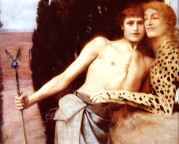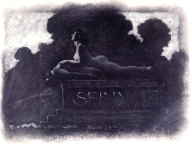The Sphinx of Greek mythology asks questions and then devours those who cannot answer her. The Greek sphinx is far from benign: she has the body of a lion, the tail of a serpent, the wings of an eagle, and the breasts and head of a woman. She is ready to claw, tantalize, and dominate the mortals — the men — who come before her. This sphinx embodies the enigmatic femme fatale, a dangerous relation to the notorious Lady Lilith.



Left to right: Carresses by Fernand Khnopff. The Kiss of the Sphinx by Franz von Stuck. Sphinx by Valère Bernard. [Click on thumbnails for larger images.]
The Decadents picked up on the power of the Sphinx's eroticism. Valere Bernard, Františec Drtikol, Franz von Stuck, Fernand Khnopff all depict her overflowing with sexuality. They explore the different modes the sphinx can take as an object of sexual desire. She can manifest her sexuality beyond her bared breasts with the strength and sinewy beauty of her animal parts (Bernard's Sphinx). She can draw the male figure close with the reassurance of a soft embrace (Khnopff's Caresses), or immobilize him with her heavy claws for a fatal kiss (von Stuck's The Kiss of the Sphinx).


Left: The Sphinx by Franz von Stuck. Right: The Sphinx by Františec Drtikols. [Click on thumbnails for larger images.]
She doesn't even need her animal parts—a nude female body in the sphinx's pose is enough to remind the viewer of the dangerous femme fatale he (or she) beholds. She can lie nude on a red velvet cloth, perfectly still for the viewer's gaze and patiently awaiting her prey (Stuck's The Sphinx), or lie posed atop her carved stone base, her face beaming to the sky with delight as a lifeless man hangs limply beneath her (Drtikols' Sphinx (Cleopatra)).
The message of the Decadents' Greek sphinx is clear — she is beauty, she is divine artifice, she is unrivaled sexuality, but most of all she is man's fatality.
Questions
1. Francis von Stuck painted both The Sphinx and The Kiss of the Sphinx in 1895. In The Sphinx he creates a portrait: the nude female subject is perfectly still and perfectly composed in the sphinx pose. His other painting The Kiss of the Sphinx is much less composed. This scene captures the aggression of the sphinx's killing methods. These different compositions lead to different decadent messages. What are the decadent qualities of each? Does one strike you as the more decadent painting?
2. Bernard and Drtikol both depict the sphinx in her victorious pose: face turned to the sky with a menacing expression and arms resting on her defeated prey. However, Bernard's is the classic sphinx figure, while Drtikol has called the nude woman a sphinx in herself. What differences does the inclusion or exclusion of the animal parts make on the subject of the sphinx? Is one more decadent than the other?
3. In Khnopff's Caresses, he sense of danger has been drastically toned down. However, the sphinx is still menacing with her toned feline forearms, thin smile and the eyes of Klimt's Judith. Here, Khnopff shows us an alternative side of the sphinx's sexual power. Is this sphinx closer to the earlier conceptions of the femme fatale?
4.In Egyptian mythology the sphinx represents wisdom, knowledge, and understanding. The Egyption sphinx is a source for answers, sought by pilgrims who seek the truthof life. Though this idol is rather benign in contrast to the dangerous Greek sphinx, the Decadents find it quite intriguing. Františec Kupka's Defiance (Black Idol) and Path of Silence, as well as Frantisec Bilek's How Time Etches Our Wrinkles, all depict this different aspect of the Decadent sphinx. What are the differences in which the Decadents handle these two subjects to achieve their decadent ends? What are the similarities?
5. How does the Decadent sphinx compare to earlier notions of the femme fatale, such as the Pre-Raphaelite version?
Related Material
Bibliography
Urban, Otto M. In Morbid Colors: Art and the Idea of Decadence in the Bphemian Lands, 1880-1914. Prague: Municipal House and Arbor Vitae Press, 2006.
Last modified 29 April 2008
